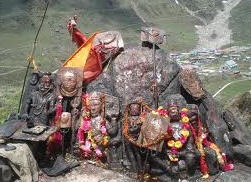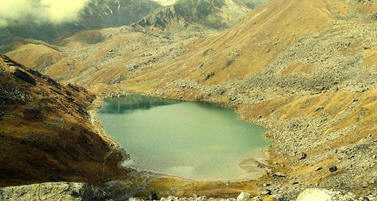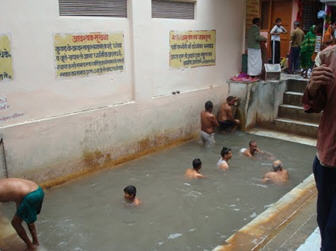There is a marble staff behind the temple that commemorates the emblem of Sankaracharya. It is believed that Sri Sankaracharya passed away in Kedarnath. There is another school of thought that says he passed away in Kanchipuram, Tamil Nadu.
Just behind the Kedarnath Temple is the Mahapanth Trail (Gate of Heaven). It is said that from this place there is a path that goes north up to Swarga-rohini (path to heaven). It is said that the five Pandavas took this path after performing a huge yajna (sacrifice). Other people said that the Pandavas ascended from Badrinath.

A path to the east of the village, to the right of the temple, leads to the Bhairava temple, the guardian deity over the temple. Bhairava is the furious form of Lord Shiva. It is a 20-minute walk.
Before you cross the bridge that crosses to the town you come to a path that leads to a glacier, 4km away. The path here can also be reached by crossing the river over the bridge that is behind the temple and climbing up the hill. Chorabari Tal lake, an emerald green lake, is next to the glacier. It is also known as Gandhi Sarovar, because some of Mahatma Gandhi’s ashes were thrown here. It takes 1½ to 2 hours to walk here from Kedarnath. About a km from the lake is the source of the Mandakini River.

Vasuki Tal (4320m) is a tough 9km trek from Kedarnath. The path begins near the Tourist Bungalow. Past Vasuki Tal is the Khatling Glacier via the Painya Tal and Maser Tal lakes. For this trek you need a good guide and proper equipment.
Travel
The road to Kedarnath ends at a town named Gaurikund (1,981m). A bus from Haridwar or Rishikesh (295km) takes an entire day to reach Gaurikund. It is best to catch the early morning bus at 6 am. If you get a later bus you will definitely have to stop for the night on the way. The bus from Gangotri to Gaurikund (334km) takes a day and a half. From Gaurikund the bus usually takes a full day to get to Joshimath , which is 44km south of Badrinath; but you could reach Badrinath the same day if you get the 6 am bus and nothing goes wrong. Otherwise, from Joshimath the same bus goes the next morning to Badrinath.
From Gaurikund you should make sure you reserve early morning buses the night before. Even if you are told you can get a ticket the next morning, do not believe it. You have to walk 14km, at least 4 hours, up a steep incline to get to Kedarnath from Gaurikund. The trek along the Mandakini River to Kedarnath is slow and tiresome. If the sky is clear, at the 10km stone you can view the Kedarnath mountain peak at 6,640m (22,770 ft). As the walk is very tough, it is advised to carry as little as possible up the hill. Even the smallest load can feel like a lead weight after a few km. If you cannot walk, you can rent a horse or carried by four people up the hill. You should be prepared to stay the night at Kedarnath, as it is difficult to go both up and down in the same day. Some people stop for the night halfway up at Rambara (7km), which has several simple eating places and some basic rest houses.

Gaurikund is said to be the place where Gaurimata (Parvati) took birth and did austerities for hundreds of years, in order to marry Lord Shiva. It is 210 km from Rishikesh and 334km from Gangotri. Gaurikund is the last bus stop on the way to Kedarnath. There is a hot sulfur water spring here named Gaurikund (Tapta Kund), where you can bathe. It is said to mark the place where Parvati did austerities. It is a great place to bathe after returning from your walk to Kedarnath. Next to the spring is the Gauri Devi Temple, dedicated to Parvati. There is a temple called Sirkata Ganesh, the beheaded Ganesh, about half a km from Gaurikund. The Skanda Purana says this was the place where Lord Shiva beheaded his son Ganesh and then gave him an elephant head. The story says that Ganesh was guarding his mother, Parvati, who was bathing in Gaurikund. When Shiva, who had been traveling for a long time came, Ganesh stopped him. Shiva, not recognizing his own son, then became angry and cut off the head of Ganesh. When Parvati found out this, she requested Shiva to bring him back to life and give him another head. Shiva said he would give him the head of the first creature that came by, which happened to be an elephant. So he gave Ganesh the head of an elephant. The ashrama of Vyasadeva’s father, Parashara Muni, is also located 40 km down from Gauri Kund in one of the villages. There is a big image of him there. You may have to ask the locals to find it if you are interested.